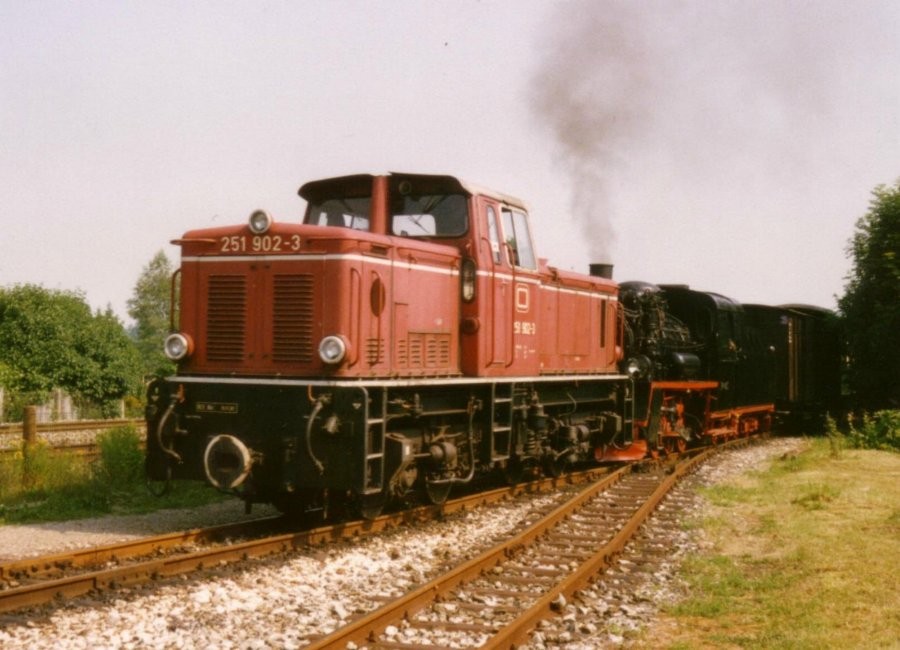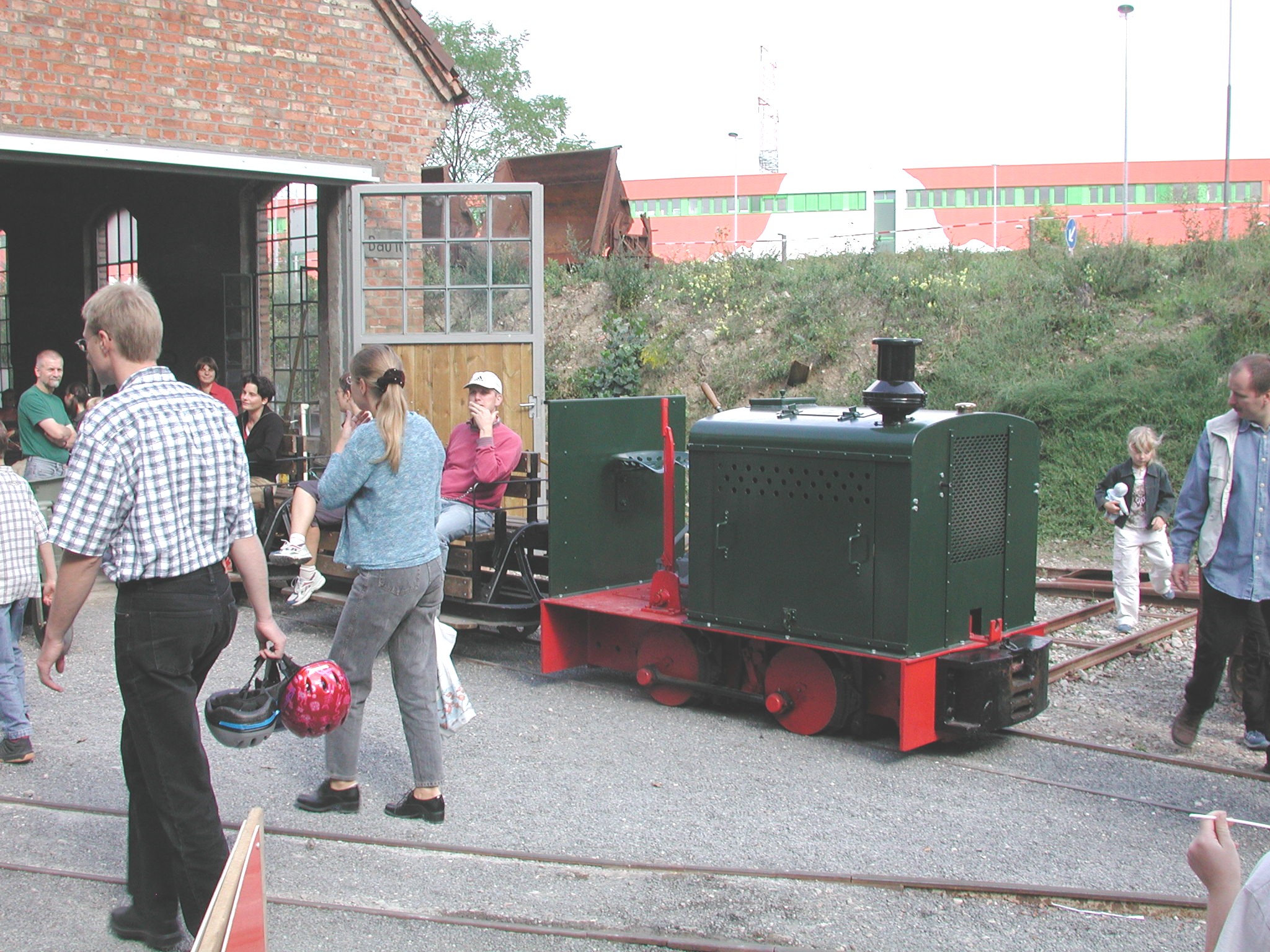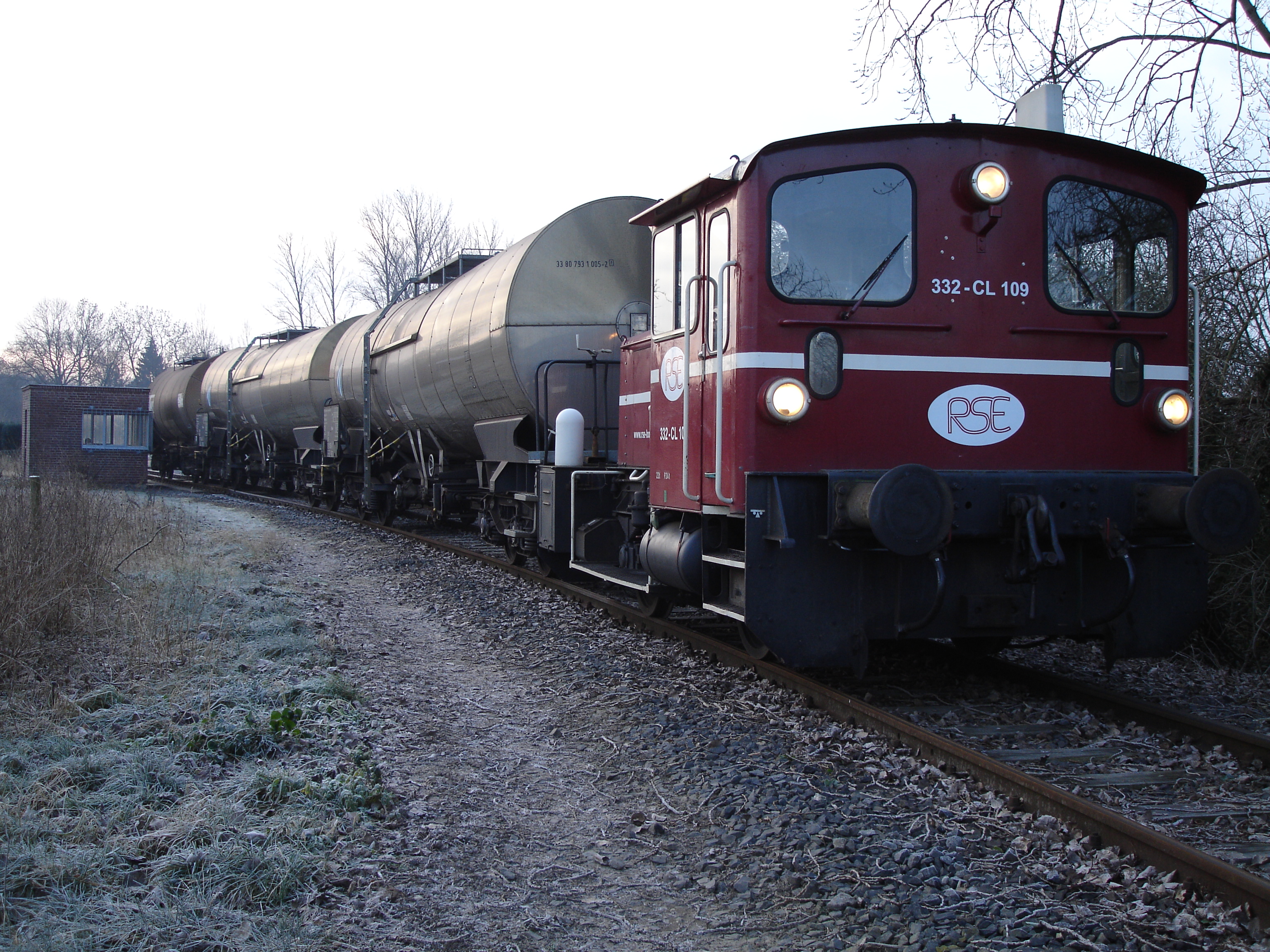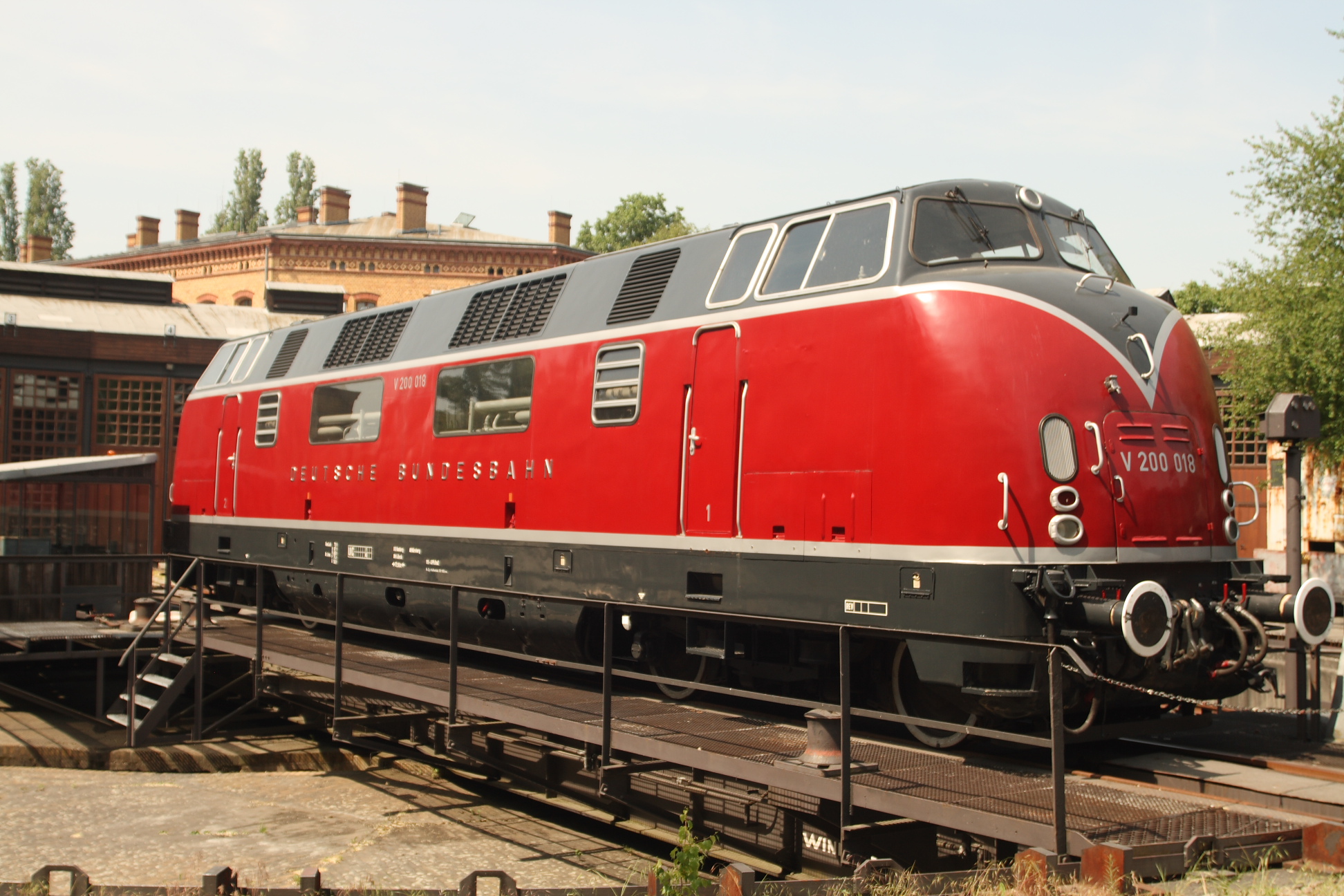|
Gmeinder
Gmeinder GmbH was a German locomotive and engineering company based in Mosbach. Its products included diesel engines, small locomotives (shunters) and other railway locomotive parts. Much of its business came through the German railways, though it also exported to the rest of Europe and the rest of the world. From 2004 onwards the company was split into two separate concerns - Gmeinder Lokomotivenfabrik which manufactures locomotives and Gmeinder Getriebe- und Maschinenfabrik which makes components - specifically railway axle gearboxes. History In 1913 The company Steinmetz Gmeinder KG was founded in Mosbach by Anton Gmeinder and August Steinmetz, six years later the company name was changed to "A. Gmeinder & Cie.". The same year a locomotive with a petrol engine was made. In 1925 another change of identity occurred - with the organisation becoming Gmeinder & Co. GmbH with Anton Gmeinder and Carl and Hermann Kaelble as co-partners. In 1964 with financial support from the state o ... [...More Info...] [...Related Items...] OR: [Wikipedia] [Google] [Baidu] |
DB Class V 169
The DB Class V 169 consisted of a single example: ''V 169 001'', derived from the DB Class V 160 family, with an additional gas turbine booster engine. It can be considered the prototype for diesel locomotives with a gas turbine as an additional drive; specifically the DB Class 210. Post 1968 the class designation was changed to ''Class 219'', and the locomotive renumbered ''219 001'' In 1999 the locomotive was heavily renovated for a private company, and does not now have the gas turbine. Post the merger of the Deutsche Bundesbahn and Deutsche Reichsbahn another locomotive - the DR Class 119 has been assigned to the DB class 219. Background From 1963 onwards the DB Class V 160 had been delivered and deployed in large numbers, and was proving successful. Thus plans were made for testing of further units were made - specifically a variant with electric train heating. These units would require more power than the engines installed in the V 160 could deliver. Three prototype unit ... [...More Info...] [...Related Items...] OR: [Wikipedia] [Google] [Baidu] |
Wiesloch Feldbahn And Industrial Museum
The Wiesloch Feldbahn and Industrial Museum (german: Feldbahn- und Industriemuseum Wiesloch, ) is a narrow-gauge railway and industrial heritage open-air museum established in 2001, at Wiesloch, Germany. The museum is centred around the former locomotive shed of the (TIW) brickworks, and houses industrial equipment from large excavators to small machine tools, plus large and small locomotives. It is north of Wiesloch-Walldorf station, lying between the River Leimbach and mainline Mannheim–Karlsruhe–Basel railway to the west, and the Bundesstraße 3 and REWE supermarket Group's south-west central warehouses to the east. History The museum is based partly on the site of the former brickworks which closed in 1989 and had been served by a 600-millimetre narrow-gauge railway network. During the 1960s the brickworks employed approximately 320 people and the narrow-gauge trains were used for transporting raw material from the clay pit to the brickworks. Following the comple ... [...More Info...] [...Related Items...] OR: [Wikipedia] [Google] [Baidu] |
DRG Kleinlokomotive Class I
The ''Kleinlokomotiven'' (literally: small locomotives) of Class I were light German locomotives of low weight and power (up to 40 PS) designed for shunting duties. They were placed in service by the Deutsche Reichsbahn (DRG) after trials had been carried out on several prototype locomotives in 1930. The power source for these locomotives was either a diesel or petrol engine. History After the Deutsche Reichsbahn had initially obtained several trials locomotives in 1930, it took delivery of production '' Kleinloks'' in 1931 and split them into two classes or 'power groups'. Locomotives in power group I, with an engine power of up to 40 PS (29 kW), were intended for shunting at small stations and in simple situations. As a result of the new numbering scheme two of the trials engines from 1930 were also included in Class I. These were locomotives V 6016 and V 6017 (from 1931 Kö 0001 and Kö 0002) delivered by the Fürst-Stolberg-Hütte works at Ilsenburg. They did not acqu ... [...More Info...] [...Related Items...] OR: [Wikipedia] [Google] [Baidu] |
WEG T 23 And 24
The Class T 23 and 24 are diesel railbuses which were procured by the Württemberg Railway Company (WEG) and then operated by the Westerwald Railway (WEBA) until 2009 on the Daade Valley Railway and now belong to the Krumbach IGEBA engineer society railway. The WEG had the two railbuses built in 1968 at Gmeinder and Auwärter for working the branch line from Nürtingen to Neuffen. They were powered by two Büssing engines with a power of 154 kW (210 PS) each. Each motor drove an axle via a Voith 501 drive. Their control system enabled them to be used as a pair. The two new railbuses hauled heavy limestone trains between a quarry near Neuffen and a cement works in Nürtingen. In order to simplify shunting operations, the WEG fitted the two railbuses and the two end wagons of the limestone trains with Scharfenberg couplers. After the transportation of limestone was ended in October 1979, the two railbuses lost their original operating route and, on 3 October ... [...More Info...] [...Related Items...] OR: [Wikipedia] [Google] [Baidu] |
DB Class Köf III
The DB railways Köf III class (after 1968 named classes 331, 332, 333 and 335) are light two axle shunting locomotives of Deutsche Bahn AG. History The German national railways had already procured small locomotives of classes Kö I (up to ) and Köf II (up to for light shunting duties at small and medium-sized railway station. These locomotives were attached to their particular station and their use resulted in shortened travel times of mixed trains since the train locomotives did not need to complete all of the shunting work before the train could proceed to the next destination. After the Second World War the small locomotives of the Köf II class were in much demand and overused, but the use of a more powerful shunting locomotive such as the class V 60 was precluded, primarily for cost reasons: Small locomotives of the Köf type were cheaper to operate since the driver did not need to be a fully qualified locomotive driver. In the 1950s, in order to close the gap bet ... [...More Info...] [...Related Items...] OR: [Wikipedia] [Google] [Baidu] |
DB Class V 200
DB Class V 200 (also known as Class 220) was the first series production diesel-hydraulic express locomotive of the German Deutsche Bundesbahn and – as Am 4/4 – of the SBB-CFF-FFS in Switzerland. History DB Service Five prototypes of the V 200 were built by Krauss-Maffei in 1953/1954. Full production began in 1956, with 61 engines being built by Krauss-Maffei and 20 by MaK. These five V 200 prototypes were put through extensive testing, the aim being to ensure the production locomotives would be as reliable as the technology and maintenance standards of the 1950s allowed. In 1955 one locomotive travelled under its own power through Yugoslavia, Greece and Turkey partly as a test and partly to demonstrate the locomotive's capability to potential customers in those countries. Initially the V 200 hauled express trains on all main lines, replacing the DRG Class 05, DRG Class 03 and DRG Class 01. Following the electrification of many main lines the V 200 was used incr ... [...More Info...] [...Related Items...] OR: [Wikipedia] [Google] [Baidu] |
British Rail Class 158
The British Rail Class 158 '' Express Sprinter'' is a diesel multiple unit (DMU) passenger train. It is a member of the Sprinter series of regional trains, produced as a replacement for British Rail's first generation of DMUs; of the other members, the Class 159 is almost identical to the Class 158, having been converted from Class 158 to Class 159 in two batches to operate express services from London Waterloo to the West of England. The Class 158 was constructed between 1989 and 1992 by British Rail Engineering Limited (BREL) at its Derby Litchurch Lane Works. The majority were built as two-car sets, some three-car sets were also produced. During September 1990, the first Express Sprinters were operated by ScotRail; the type was promptly introduced to secondary routes across the Midlands, Northern England, Wales and the South West. The Class 158 enabled the replacement of large numbers of elderly DMUs but also several locomotive-hauled trains as well; this was partially a ... [...More Info...] [...Related Items...] OR: [Wikipedia] [Google] [Baidu] |
British Rail Class 151
The British Rail Class 151 was a prototype class of diesel multiple unit (DMU) developed and constructed by the British railway equipment manufacturer Metro Cammell. It was designed primarily to serve as a successor to the earlier first-generation "Heritage" DMUs operated by the British Rail (BR). Development of the Class 151 commenced during 1983 in response to a specification issued by BR calling for a new generation of DMU with which to equip its fleet. Both Metro Cammell and British Rail Engineering Limited (BREL) were selected to produce prototypes of their design submissions. Accordingly, a pair of 3-car units were constructed, which entered trial service with BR during 1985. If it had emerged successful, the Class 151 would have likely become the basis of ''Sprinter'' family of DMUs that were produced during the 1980s. However, following a competitive evaluation against the rival Class 150, the type did not secure a production contract, having lost out to its BREL-buil ... [...More Info...] [...Related Items...] OR: [Wikipedia] [Google] [Baidu] |
British Rail Class 140
The British Rail Class 140 was the prototype of the ''Pacer'' diesel multiple unit. It was constructed between 1979 and 1981 in response to a desire within British Rail to develop a capable railbus for its smaller branch line services. Much of the bodywork was constructed using Leyland National bus components, with the exception of the cabs. Based on the single car railbus prototypes, the Class 140 was built to BR's then stringent regulations regarding crashworthiness and resistance to end loading; as such, much of its intention lightweight 'bus on a wagon' look was lost, becoming a more substantial vehicle. Throughout the 1980s, the sole member of the class functioned as a trials and demonstration unit, acting as a herald to the closely-related Class 141. Since its withdrawal, the unit has been preserved at the Keith and Dufftown Railway. Background By the beginning of the 1980s, British Rail (BR) operated a large fleet of first generation DMUs, which had been constructed ... [...More Info...] [...Related Items...] OR: [Wikipedia] [Google] [Baidu] |
DB Class 360
The DB Class V 60 is a German diesel locomotive operated by the Deutsche Bundesbahn (DB) and later, the Deutsche Bahn AG (DB AG), which is used particularly for shunting duties, but also for hauling light goods trains. Seventeen locomotives were bought used by the Norwegian State Railways and designated NSB Di 5. Also the Yugoslav Railways bought used units, and designated them JŽ 734; they were subsequently designated Series 2133 by the Croatian Railways. History The DB had a shortage of small shunters. As a result, in 1951, a diesel shunter was designed, almost all the major locomotive firms being involved in its development and production. The new class was initially called the V 60. In 1955 the first prototype locomotives, V 60 001–004, were delivered by Krupp, Krauss-Maffei, Mak and Henschel, each having different engines. Later that same year orders for the first production locomotives were issued; they were to have GTO 6 or GTO 6A motors from Maybach. Several of the lo ... [...More Info...] [...Related Items...] OR: [Wikipedia] [Google] [Baidu] |
DRG Kleinlokomotive Class II
German ''Kleinlokomotiven'' (literally: small locomotives) like the DRG Kö II (later: Köf II) were developed as locomotives with a low weight and driving power for light shunting duties. There were two classes, based on engine power. The Class II were engines which developed more than 40 (later 50) HP. After tests with several trial locomotives, they were placed in service from 1932 onwards by the Deutsche Reichsbahn (DRG) and used on small stations for light shunting and marshalling work. They were intended to make the handling of goods traffic more economical. To do that, an appropriately trained controller had to be able to handle shunting duties using the locomotive. Accordingly, the locomotive was designed to be robust and easy to operate. Technology Light locomotives mainly used diesel motors (originally classified as ''Kö/Köf/Köe'' by the DRG), as their source of energy, but there were also versions with Benzol motors, designated as ''Kb/Kbf/Kbe'', and with elec ... [...More Info...] [...Related Items...] OR: [Wikipedia] [Google] [Baidu] |
251 902-3 Warthausen 17
51 may refer to: * 51 (number) * The year ** 51 BC ** AD 51 ** 1951 ** 2051 * ''51'' (film), a 2011 American horror film directed by Jason Connery * "Fifty-One "Fifty-One" is the fourth episode of the fifth season of the American television crime drama series '' Breaking Bad'', and the 50th overall episode of the series. Written by Sam Catlin and directed by Rian Johnson, it originally aired on AMC i ...", an episode of the American television drama series ''Breaking Bad'' * ''51'' (album), a 2012 mixtape by rapper Kool A.D. * "Fifty One", a song by Karma to Burn from the album '' V'', 2011 {{Numberdis ... [...More Info...] [...Related Items...] OR: [Wikipedia] [Google] [Baidu] |







